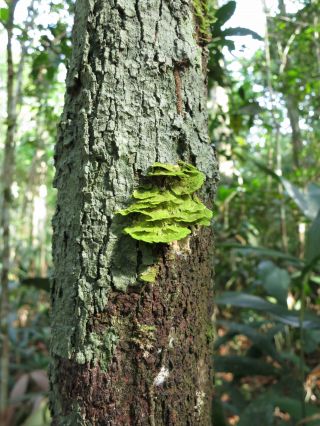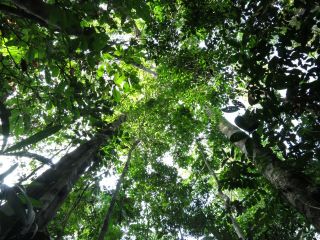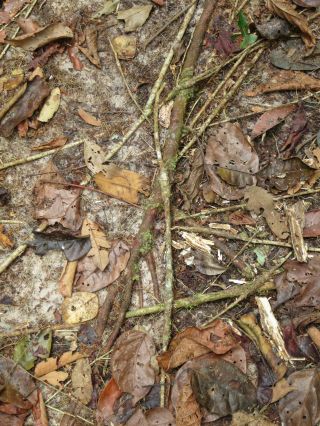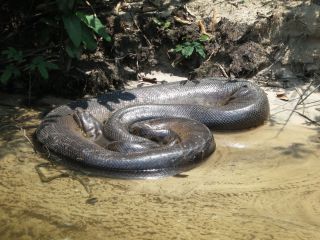Singing the praises of greenery
By Mark Brazil | Oct 21, 2012
This year’s annual hop between the hemispheres in my capacity as a globetrotting nature-tour guide took me to my namesake country, Brazil, with strange and unusual hopes.Following the almost unprecedented heat of this year’s August in Hokkaido, I wondered if, for once, September’s spring in Brazil may actually feel cooler than Japan. But not so!
I am weak against heat and humidity, and despite annual visits to the tropics I have never adjusted to my skin being constantly slick with perspiration that’s unable to evaporate into an already moisture-laden atmosphere. Yet I know from repeated experience how that humidity contributes to supporting life in astonishingly diverse forms. So for me, my annual trip to the humid tropics turns into a kind of perverse penance in a biologist’s paradise.
But whether in South America, Africa or Asia (including Japan’s own southernmost islands), the humid tropics and subtropics are not just about heat and airborne moisture content, they are also about color — and one color above all dominates: green.
I have long been aware of my personal reaction to immersion in green in forested landscapes around the world, but a little research soon reveals I am not alone, and that there is a more generalized response to this with deep-seated visual, psychological, cultural and health implications.
The retina cells in the back of our eyes that are sensitive to different wavelengths of light are known as cone cells, of which we have three types, giving us what’s called trichromatic color vision. What this means is that we are not just sensitive to light, but to three particular “subsets” of light — primary colors red, green and blue.
Astonishingly, our brains do the rest, combining those three colors in all kinds of permutations that allow us to observe an infinitely varied, multicolored and shade-rich world.
Colors are crucially important to us — but not just aesthetically. With the United Nations World Health Organization now estimating that depression and related conditions will become the greatest source of ill health by 2020 — and research revealing the beneficial psychological and self-esteem effects of exposure through “green exercise” — it is time to celebrate that one of the three primary colors.
Enter a tropical forest and there are cascades of green, in all manner of shades, more shades in fact than I could ever find words to describe. There are greens bursting with vibrancy; greens delicate as filigree fronds; greens so thick and heavy with life they seem tenacious; and greens dark and powerful, overwhelmingly strong, seemingly clawing and grasping at the light.
Then there are the trees’ trunks — some rugged, some smooth, some crowded and clad with green epiphytes — all towering up into the canopy, their arm-like branches stretching out as if claiming ownership of the light-giving sky. Hand-like fronds and myriad finger-like leaves splay out from those branches, at once clutching at raining photons and at the same time shielding the leaves of younger, paler-green plants below, forcing them to grasp, to scrabble and claw upward, pallid in their desperation for light.
Altogether, the dense, light-draining foliage creates a green aura dappled with chinks of sunlight. In this world of greens, even the brilliantly colored broken patterns of avian plumage such as those sported by the forest’s emblematic parrots and hummingbirds somehow blend in so well that it’s surprisingly hard to pick out these winged jewels.
Then there are the megatrees of South America’s Amazonia. These timber pillars that tower up beyond the vast canopy have sprung from seeds spread centuries before the European colonization of the Americas. Yet though such trees may be ancient, the forest itself is truly prehistoric, dating back some 55 million years to even before the Andean mountain range, the continent’s other mega-feature, thrust upward by tectonic activity.
The near-timeless existence of so huge and lush a forest growing from poor, often sandy or rocky soils seems miraculous to the point of incredulity until you take into account that more than half of its nutrients come airborne across the Atlantic Ocean, whipped high into the atmosphere by winds over the Sahara and Sahel and then spread out over the vast carpet of green clothing the broadest expanse of South America.
While the green of foliage dominates the dome of life above in the forest, beneath is green’s antithesis: brown, the color of decay.
The forest floor is littered with as many shades and shapes of brown as the sky-obscuring foliage above has greens in its vast palette. There are brittle yellow-browns that rustle or crack; browns that snap; browns that bend and whisper; and those browns so molded and rotten as to near the blackness of humus and crumble at the gentlest touch.
On the ground beneath those towering green cathedral-like pillars and arches there are, too, fallen leaves the length of my arm but wider; hand-size leaves all fringed and tapered, their elongated, sharp-pointed drip tips adept at shedding water in life, but now mere vestiges of net venation; and, of course, tiny leaves in uncountable numbers. Many of these browning, ground-covering fallen leaves show signs of past indignities — holes where crickets have grazed, crescentic cuts where leaf-cutter ants have foraged, pale tracks showing the traces of leaf-mining insects — and all under an accumulated load of fungus and lichen.
Life-giving precipitation can linger on living leaves, the drops like magnifying lenses focusing sunlight and burning brown patches into tissues — or else those same drops can provide the perfect medium for epiphytic growth; green growing on green, one bane of a forest tree’s existence.
Here, where trees shed their leaves individually, not all together seasonally but randomly and asynchronously, the green of the canopy is not the color of summer: It is a perennial color. Similarly, the brown of the forest floor is not the color of the end of autumn and a prelude to winter, but a year-round hue.
Look upward into the almost intermeshing umbrella-like canopy of apparent confusion and, after careful observation for a while, you’ll see it resolves into layer upon layer of growth; the uppermost canopy consisting of tree-crown patterns that almost meet, yet rarely merge as if they’re soft-edged pieces of an immensely complex living jigsaw, interlocking yet never overlapping.
From below, the deep green of the canopy is shot through with idle rays of sunlight that pierce chinks and gaps in the mesh-mail of foliage above; the canopy seems like a vast ancient roof enclosed in stained glass of just one color but many shades.
See it in profile, however, and the same canopy takes on a very different appearance that’s no longer flat and roof-like. Instead, the tree crowns are like tight ranging peaks of weathered mountains, split, and encircled by valleys, separated by deep gorges, and here and there with deep sinkholes plunging down where a forest giant has been lightning-blasted or has fallen beneath its multiple burdens of fungal rot, draping vines and weighty epiphytes to open a patch to life-giving light.
Beneath this high-vaulted canopy and its many lower layers, a detrital rain of cast-off leaves, fallen flowers and fruits, twigs and storm-busted branches reaches the ground, joining massive fallen trunks. There, the detritus changes steadily from green and brown to almost black, under an overwhelming army of all-devouring ants, termites and fungal hyphae.
Nets of roots and rootlets, too, spread surprisingly close to or on the surface. There is so little soil for them to penetrate into that to walk here is to cross an endless array of toe-catching loops and kinks of raised roots — fail to focus on your footfalls at your peril.
In contrast to the view from the ground, meandering through the forest by river presents a whole new and different perspective. Seeing the rugged nature of the canopy in profile reveals its “waterfalls” of foliage — cascades of vines and creepers that drape the trees and fall almost to the water’s surface.
Yet again, to scan above the forest from a canopy tower or, better still, to fly over it is to see it as a strangely uneven sward, one shrunken by distance so that far down below it appears like an immense, dense field of giant broccoli.
Meanwhile, far from South America’s ocean of vegetation, with its river dolphins, tapirs, jaguars, iridescent hummingbirds and all, the end of this year’s period of green is fast approaching in the northern half of Japan, from central Honshu to Hokkaido. Here, where the forests are dominated by temperate tree species, that loss would perhaps be nothing to celebrate, were it not followed by another glorious color: red. And fall colors are not something that even remotely impinge on life in Amazonia!




